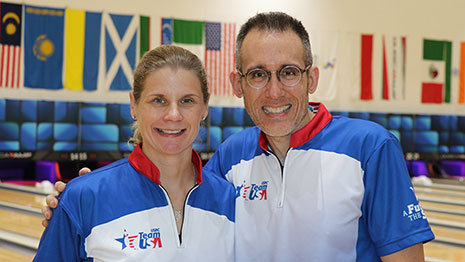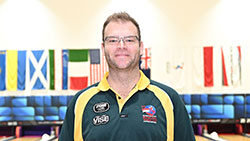First day at 2019 QubicaAMF World Cup offers learning opportunity for Team USA
November 18, 2019

PALEMBANG, Indonesia - Since it's the middle of football season in the United States, Team USA head coach Rod Ross came up with a timely analogy to describe this week's QubicaAMF Bowling World Cup, which got underway Monday at the Jakabaring Sport City Bowling Center.
Ross equated the opening day of qualifying at the 2019 event to the first quarter of a football game, and the distant goal of advancing to the top 24 as making the playoffs.
Regardless of how things started for Team USA's Kelly Kulick and John Janawicz, there's still plenty of time left to find and maintain a rhythm on this year's 41-foot oil pattern. Each day, or quarter, will be an opportunity to learn and improve.
Kulick finished Monday's opening round with a 247 game to surge into second place overall with a 1,293 total. The 42-year-old right-hander trails Malaysia's Natasha Roslan, who paced the 60-player women's field with a 1,306 effort, a 217.67 average.
Brazil's Stephanie Martins is third with 1,235 and followed by Jeon Eunhee of Korea (1,232) and Sarolta Dosztaly of Hungary (1,209).
"I learned today that my theory right now is correct, and that is to stay closer to the track area and not get forced left too quickly," said Kulick, a 15-time Team USA member. "Medium patterns have multiple angles to be played, and the majority of the women are staying to the right, which does help me. Ultimately, it's all about execution. If I execute each shot, then I will get a good read of each lane and be able to trust my instincts."
Kulick preceded the big finish with games of 214, 171, 213, 247 and 201.
During her second game, she was able to recognize the things that went wrong, which included allowing her feet to get too fast. That resulted in poor shot making.
Kulick also was aware of the things going on around her, and she attributed some of her success to being able to watch bowlers like Martins and Jeon. Though they don't throw the ball the same as her, seeing how they were attacking the lanes was helpful.
The day went a little differently for Janawicz, who struggled with his execution and finished 36th in the 73-player men's field.
 South African right-hander Francois Louw, who is making his fourth World Cup appearance, averaged more than 224 over his six games Monday to top the men's standings with a 1,345 total.
South African right-hander Francois Louw, who is making his fourth World Cup appearance, averaged more than 224 over his six games Monday to top the men's standings with a 1,345 total.
Latvia's Daniel Vezis is second with 1,302 and followed by Christopher Sloan of Ireland (1,290), Lee Wanhee of South Korea (1,288) and Jasem Alsaqer of Kuwait (1,271).
"Today was just bad execution, and there really isn't that much more to say," said Janawicz, a 47-year-old right-hander and nine-time member of Team USA. "It's hard to make good ball adjustments and line adjustments when you can't make more than three shots the same. I got caught in a bad rut and fought through it the first couple games, but then when I had to move in and try to hook it, I had a hard time getting the ball to the right."
Janawicz rolled games of 190, 235, 192, 161, 195 and 163. He said he never was able to get comfortable physically and never felt confident that the ball actually would go where he was looking.
Now, he will rely on his experience and patience to rebound during Tuesday's second round.
"Sometimes, you just have to let these days go and come in for the next round with a clear mind," Janawicz said. "I feel like I had a pretty good game plan as far as lane play, but my execution just seemed to get worse as the block went on, which is aggravating. They were tricky today, but they weren't as hard as I made them look at times."
Patience is something Ross mentioned many times leading into the qualifying portion of the 2019 World Cup.
While Janawicz and Kulick, both United States Bowling Congress Hall of Famers, are participating for the first time, Ross has been around the event enough times to understand how important it is to be versatile, open-minded and patient when it comes to the long format and diverse field.
"It's about having the patience to see what works and what doesn't work and be confident with the moves and adjustments," Ross said. "One thing we're really good at is learning. It's early, and we didn't lose anything today. We just learned, and that will help us be more prepared for tomorrow. We expect people to be playing the lanes a little bit differently based on what they experienced today, too, but we think we can build on the things that went well and make changes based on the things that didn't."
Competition at the 2019 World Cup, the 55th edition of the storied event, will resume Tuesday morning, with the women hitting the lanes at 9 a.m. local time (Monday at 9 p.m. Eastern). The men will begin their second day of qualifying at 2 p.m. local time (Tuesday at 2 a.m. Eastern). The order will change for each of the four days of qualifying.
All competitors will bowl 24 games of qualifying (six games each day), before the field is cut to the top 24 for eight additional games. Total pinfall after 32 games will determine the eight men and eight women who will advance to round-robin match play.
The top four in each division then will move on to the knockout-style semifinals based on their 40-game totals, including bonus pins for each win in match play.
The defending champions at the World Cup are the United States (Shannon O'Keefe) on the women's side and Australia for the men.
Australia's Sam Cooley is at the 2019 event to defend his title. He finished the first day of qualifying in 19th place with a 1,204 total.
Additional past winners in the field include Aumi Guerra of the Dominican Republic (2010, 2011) and Krizziah Lyn Tabora of the Philippines (2017).
The World Cup first was contested in 1965, and the tournament now is considered one of the sport's most prestigious singles titles. It also is recognized as the largest event in the sport in terms of number of countries competing.
The last time the event was held in Indonesia was in 1980, when it visited Jakarta.
To see the complete schedule for the 2019 World Cup, visit QubicaAMF.com.
Ross equated the opening day of qualifying at the 2019 event to the first quarter of a football game, and the distant goal of advancing to the top 24 as making the playoffs.
Regardless of how things started for Team USA's Kelly Kulick and John Janawicz, there's still plenty of time left to find and maintain a rhythm on this year's 41-foot oil pattern. Each day, or quarter, will be an opportunity to learn and improve.
Kulick finished Monday's opening round with a 247 game to surge into second place overall with a 1,293 total. The 42-year-old right-hander trails Malaysia's Natasha Roslan, who paced the 60-player women's field with a 1,306 effort, a 217.67 average.

Brazil's Stephanie Martins is third with 1,235 and followed by Jeon Eunhee of Korea (1,232) and Sarolta Dosztaly of Hungary (1,209).
"I learned today that my theory right now is correct, and that is to stay closer to the track area and not get forced left too quickly," said Kulick, a 15-time Team USA member. "Medium patterns have multiple angles to be played, and the majority of the women are staying to the right, which does help me. Ultimately, it's all about execution. If I execute each shot, then I will get a good read of each lane and be able to trust my instincts."
Kulick preceded the big finish with games of 214, 171, 213, 247 and 201.
During her second game, she was able to recognize the things that went wrong, which included allowing her feet to get too fast. That resulted in poor shot making.
Kulick also was aware of the things going on around her, and she attributed some of her success to being able to watch bowlers like Martins and Jeon. Though they don't throw the ball the same as her, seeing how they were attacking the lanes was helpful.
The day went a little differently for Janawicz, who struggled with his execution and finished 36th in the 73-player men's field.
 South African right-hander Francois Louw, who is making his fourth World Cup appearance, averaged more than 224 over his six games Monday to top the men's standings with a 1,345 total.
South African right-hander Francois Louw, who is making his fourth World Cup appearance, averaged more than 224 over his six games Monday to top the men's standings with a 1,345 total. Latvia's Daniel Vezis is second with 1,302 and followed by Christopher Sloan of Ireland (1,290), Lee Wanhee of South Korea (1,288) and Jasem Alsaqer of Kuwait (1,271).
"Today was just bad execution, and there really isn't that much more to say," said Janawicz, a 47-year-old right-hander and nine-time member of Team USA. "It's hard to make good ball adjustments and line adjustments when you can't make more than three shots the same. I got caught in a bad rut and fought through it the first couple games, but then when I had to move in and try to hook it, I had a hard time getting the ball to the right."
Janawicz rolled games of 190, 235, 192, 161, 195 and 163. He said he never was able to get comfortable physically and never felt confident that the ball actually would go where he was looking.
Now, he will rely on his experience and patience to rebound during Tuesday's second round.
"Sometimes, you just have to let these days go and come in for the next round with a clear mind," Janawicz said. "I feel like I had a pretty good game plan as far as lane play, but my execution just seemed to get worse as the block went on, which is aggravating. They were tricky today, but they weren't as hard as I made them look at times."
Patience is something Ross mentioned many times leading into the qualifying portion of the 2019 World Cup.
While Janawicz and Kulick, both United States Bowling Congress Hall of Famers, are participating for the first time, Ross has been around the event enough times to understand how important it is to be versatile, open-minded and patient when it comes to the long format and diverse field.
"It's about having the patience to see what works and what doesn't work and be confident with the moves and adjustments," Ross said. "One thing we're really good at is learning. It's early, and we didn't lose anything today. We just learned, and that will help us be more prepared for tomorrow. We expect people to be playing the lanes a little bit differently based on what they experienced today, too, but we think we can build on the things that went well and make changes based on the things that didn't."
Competition at the 2019 World Cup, the 55th edition of the storied event, will resume Tuesday morning, with the women hitting the lanes at 9 a.m. local time (Monday at 9 p.m. Eastern). The men will begin their second day of qualifying at 2 p.m. local time (Tuesday at 2 a.m. Eastern). The order will change for each of the four days of qualifying.
All competitors will bowl 24 games of qualifying (six games each day), before the field is cut to the top 24 for eight additional games. Total pinfall after 32 games will determine the eight men and eight women who will advance to round-robin match play.
The top four in each division then will move on to the knockout-style semifinals based on their 40-game totals, including bonus pins for each win in match play.
The defending champions at the World Cup are the United States (Shannon O'Keefe) on the women's side and Australia for the men.
Australia's Sam Cooley is at the 2019 event to defend his title. He finished the first day of qualifying in 19th place with a 1,204 total.
Additional past winners in the field include Aumi Guerra of the Dominican Republic (2010, 2011) and Krizziah Lyn Tabora of the Philippines (2017).
The World Cup first was contested in 1965, and the tournament now is considered one of the sport's most prestigious singles titles. It also is recognized as the largest event in the sport in terms of number of countries competing.
The last time the event was held in Indonesia was in 1980, when it visited Jakarta.
To see the complete schedule for the 2019 World Cup, visit QubicaAMF.com.





